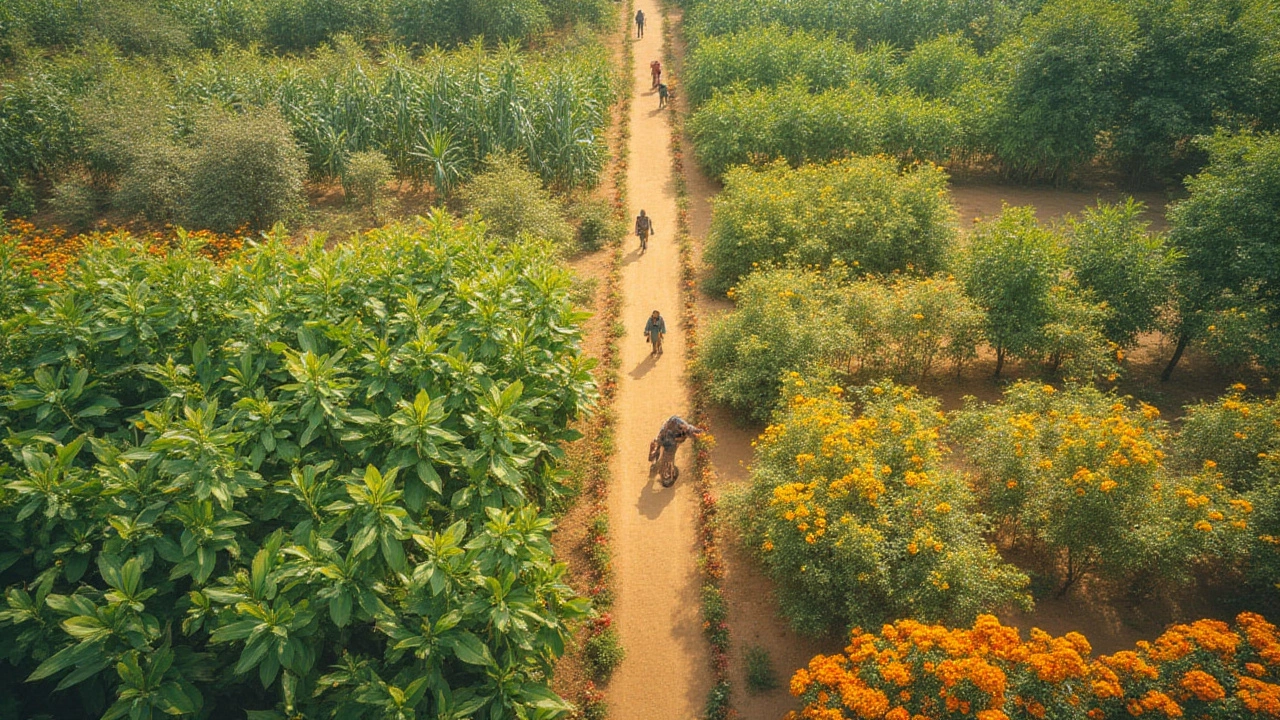Imagine biting into a crisp apple, confident it hasn’t been bathed in harsh chemicals. Sounds too good to be true? Until recently, most people couldn't even picture a world where farming didn’t lean on synthetic pesticides. Yet, it turns out ditching those old-school sprays isn’t a far-fetched dream—plenty of farmers and scientists are proving it can be done. More families today crave food that’s fresh, safe, and planet-friendly. But with global food demands at a record high and fierce pests keeping farmers up at night, the search for realistic alternatives to pesticides is heating up. Turns out, Mother Nature has her own toolkit—and she'd probably laugh at our love of chemical shortcuts if plants could talk.
Understanding Why We Need Alternatives
So, why the big fuss about finding a good alternative to pesticide? Here’s the thing: while pesticides have helped boost food production since the 1940s, they come with baggage. Studies from the World Health Organization show that about 385 million people accidentally suffer from pesticide poisoning each year. That’s not counting the harm done to bees, butterflies, and the soil that grows our lunch and dinner. Remember the Great Bee Die-Off of the 2010s? One major finger pointed at neonicotinoid pesticides—a problem so big, the EU banned several of them by 2018.
There’s also more at stake than bugs. Repeated spraying has bred "superbugs" and "superweeds"—pests that laugh at regular poisons. And those chemicals don’t just stay on farms. Rain can send them draining into rivers. A 2022 survey in the U.S. revealed that over 90% of stream water contains at least one pesticide residue. This stuff doesn’t stay put.
So, if we keep using pesticides blindly, we risk soil erosion, water pollution, and fewer natural pollinators. As people learn more about these threats, they’re piling pressure on retailers and farmers to adopt safer, cleaner ways of keeping crops healthy. The good news? Farmers have plenty of choices, many backed by modern science or old wisdom from Indigenous cultures. Let’s dig into what’s really working beyond the spray bottle.

Natural Pest Control Methods Worth Trying
When folks first think of not using pesticides, they might picture fields overrun by bugs. Yet, real-life success stories keep popping up. So, what natural tricks actually hold up on big farms, not just pretty backyard gardens?
First up: biological control. This method uses a pest’s natural enemies—think ladybugs eating aphids or parasitic wasps targeting caterpillar eggs. In 2023, California’s $2 billion strawberry industry made headlines: they cut chemical sprays in half using tiny wasps and predatory mites. The best part? These helpers only munch on bad bugs, so crops and good insects stay safe. Bio-control isn’t just some hippie idea. The U.N. Food and Agriculture Organization (FAO) lists it as one of the top ways to protect crops without risk to people or wildlife.
Then there’s crop rotation. Pests often live and breed in one type of crop. Rotate corn with legumes or leafy greens, and pests get confused or lose their food source. Rice paddies in Japan have practiced this since the 1500s, growing rice and duckweed together for pest control. That’s older than most dictionaries.
How about pheromone traps? These trick male insects with scents that mimic females, stopping them from finding real mates. Used right, these traps can wipe out pest populations in orchards and vineyards. A recent trial in Spain saw codling moth damage drop 80% in apple farms using pheromone lures instead of sprays.
Barriers work surprisingly well. Fine nets keep out fruit flies, and sticky traps nab flying pests without chemicals. For home gardeners, copper tape easily blocks slugs and snails.
Natural sprays are gaining traction, too. Neem oil—pressed from the neem tree—has been a bug fighter in India for centuries. When sprayed on crops, it disrupts pest growth without harming pollinators. In 2024, a study from the University of Nairobi found that neem oil cut cabbage moth damage by 70% with zero impact on bees.
Curious about numbers? Here’s a quick look at the impact of some alternatives:
| Method | Pest Reduction (%) | Notable Side Effects | Main Users |
|---|---|---|---|
| Biological Controls | 60-90 | Very low, specific to pests | Fruit, vegetable, and greenhouse farms |
| Crop Rotation | 40-70 | Improved soil health | Grain and vegetable growers |
| Pheromone Traps | 50-80 | Requires maintenance | Vineyards, orchards |
| Neem Oil | 60-75 | Low toxicity, breaks down quickly | Organic farms, gardeners |
| Physical Barriers | 70-95 | Labor-intensive | Greenhouses, specialty crops |
Diversifying a farm isn’t just trendy. Intercropping—growing several crops together—confuses pests and helps soil recover nutrients. Marigolds are often planted next to tomatoes; their smell drives away nematodes, a nasty root pest. And push-pull farming, now big in African maize fields, uses "push" plants to drive pests out and "pull" plants to lure them into traps. It’s clever, cheap, and proven to double yields in some Kenyan communities.
If you’re worried natural options sound complicated or expensive, consider this: Iowa State University’s 2022 study found that farmers who used at least two natural methods spent 24% less on pest control after the first year, with yields staying the same or going up. Those savings tick up every year fewer chemicals are sprayed, since pests don’t build up resistance as quickly. Sometimes the best way to fight pests is by unleashing an army of bugs, birds, and microbes—all free, if you know how to attract them.
"The future of agriculture depends on smarter strategies, not heavier chemical use. Our research proves that natural controls can protect harvests while preserving pollinators and clean water." — Dr. Selena Martinez, lead entomologist, Cornell Cooperative Extension
That doesn’t mean natural alternatives work like magic. They take fine-tuning and patience, figuring out what works best for each field and climate. But if you want food free from sticky chemical residues, these options offer hope and proof it can be done.

Blending Approaches: Integrated Pest Management (IPM) and Expert Tips
So, what’s the secret sauce when it comes to getting serious about chemical-free farming? The big winner in the field is Integrated Pest Management, or IPM. Think of it as a recipe. You don’t just use one ingredient. Instead, you mix and match the best eco-friendly methods—like those natural bug-eaters, crop mixes, and selective sprays—to keep bugs guessing and plants strong. The trick with IPM is you monitor pests closely and only act when real trouble brews, not just at the hint of a bug.
According to the USDA, farms using IPM saw a 38% drop in pesticide use between 2007 and 2022. That’s not a fluke. When Yale University researchers looked at 520 organic and conventional farms over five years, they found those that blended several strategies—physical, biological, and cultural controls—had the lowest pest outbreaks and saved more money in the long run.
What do the best IPM programs look like in the real world? Start with regular monitoring: walk fields after rain, check leaves, track insect numbers with sticky cards. Once you know what’s out there, pick the gentlest fix first. Neem spray before sunrise? Sure. Release lacewings next week? Even better.
- Predict and Prevent: Healthy soil makes stronger plants, so boost your dirt with compost and cover crops. Fewer stressed-out plants means fewer pest invitations.
- Encourage Good Bugs: Plant flowers with flat heads—think dill or yarrow—along field edges. These invite wasps and flies that hunt pests for you.
- Keep Weeds in Check: Mulch thickly to smother weed seedlings, instead of spraying herbicides. Bonus: Your soil holds more water.
- Change Things Up: Break up big fields into strips or rotate crops each season. The more unpredictable your farm is, the harder it is for pests to settle in.
- Educate and Cooperate: If you farm near others, share what tricks work best. Shared success stamps out big pest outbreaks that ignore fences.
Even for city gardeners or tiny backyard plots, these ideas scale down perfectly. Got aphids on the basil? Blast them off with water, then check back in two days. Cucumbers plagued by beetles? Try a fabric cover for a week and see if they clear up.
For folks thinking, "This all sounds like too much work," remember—technology is catching up. Drones with bug-spotting cameras, smart traps that send alerts to your phone, and apps that identify pests from a photo. In 2025, Australian wheat farmers used drone seeding followed by precision ladybug releases—yield losses from greenfly dropped by half. High-tech doesn’t have to mean more chemicals; sometimes it just means smarter, faster response times.
Honestly, the future of pest control is headed right back to its roots: working with nature, not battling against it. And the more farmers, gardeners, and eaters who demand and support these changes, the sooner pesticide-free fields become the new normal. With every farm that takes a step off the pesticide treadmill, the air clears, the bees return, and those worry-free bites of fruit and veggies become just that little bit sweeter.

